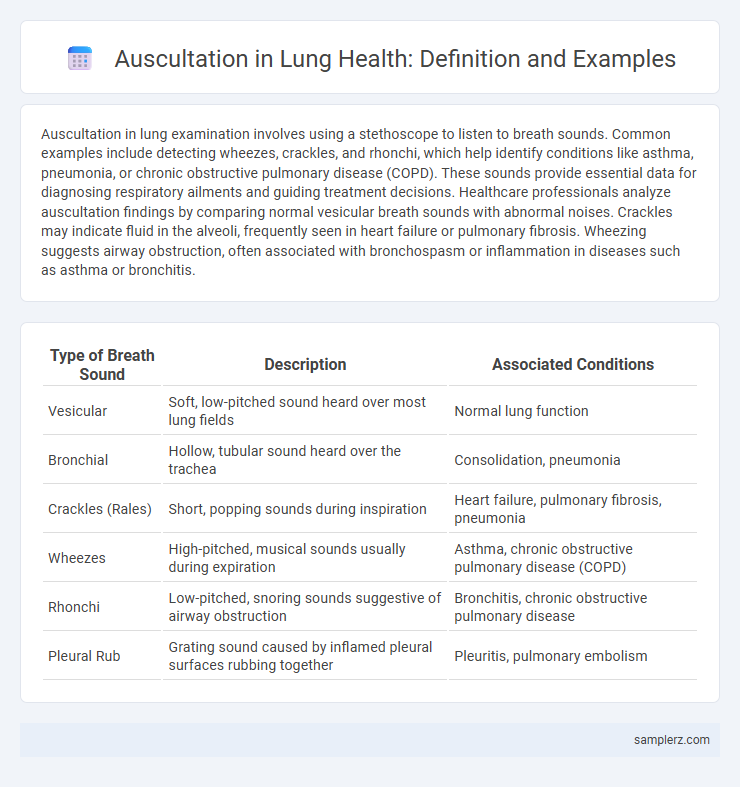Auscultation in lung examination involves using a stethoscope to listen to breath sounds. Common examples include detecting wheezes, crackles, and rhonchi, which help identify conditions like asthma, pneumonia, or chronic obstructive pulmonary disease (COPD). These sounds provide essential data for diagnosing respiratory ailments and guiding treatment decisions. Healthcare professionals analyze auscultation findings by comparing normal vesicular breath sounds with abnormal noises. Crackles may indicate fluid in the alveoli, frequently seen in heart failure or pulmonary fibrosis. Wheezing suggests airway obstruction, often associated with bronchospasm or inflammation in diseases such as asthma or bronchitis.
Table of Comparison
| Type of Breath Sound | Description | Associated Conditions |
|---|---|---|
| Vesicular | Soft, low-pitched sound heard over most lung fields | Normal lung function |
| Bronchial | Hollow, tubular sound heard over the trachea | Consolidation, pneumonia |
| Crackles (Rales) | Short, popping sounds during inspiration | Heart failure, pulmonary fibrosis, pneumonia |
| Wheezes | High-pitched, musical sounds usually during expiration | Asthma, chronic obstructive pulmonary disease (COPD) |
| Rhonchi | Low-pitched, snoring sounds suggestive of airway obstruction | Bronchitis, chronic obstructive pulmonary disease |
| Pleural Rub | Grating sound caused by inflamed pleural surfaces rubbing together | Pleuritis, pulmonary embolism |
Understanding Auscultation: Basics in Lung Examination
Auscultation in lung examination involves listening to breath sounds using a stethoscope to detect abnormalities such as wheezing, crackles, or decreased breath sounds. Normal vesicular breath sounds indicate healthy lung tissue, while adventitious sounds like rhonchi or stridor may signal conditions like bronchitis or airway obstruction. Mastering auscultation techniques enhances early diagnosis and management of respiratory diseases such as pneumonia, asthma, and COPD.
Importance of Lung Auscultation in Clinical Practice
Lung auscultation is essential for detecting abnormal breath sounds such as wheezes, crackles, and rhonchi, which indicate underlying respiratory conditions like asthma, pneumonia, or chronic obstructive pulmonary disease (COPD). Accurate auscultation helps clinicians assess lung function and guides timely diagnosis and treatment plans, improving patient outcomes. Incorporating lung auscultation into routine exams enhances early identification of pulmonary complications and informs decisions for further diagnostic testing.
Common Lung Sounds Identified During Auscultation
Common lung sounds identified during auscultation include vesicular breath sounds, bronchial breath sounds, and adventitious sounds such as crackles, wheezes, and rhonchi. Crackles often indicate fluid in the alveoli, commonly associated with pneumonia or heart failure, while wheezes suggest airway obstruction seen in asthma or chronic obstructive pulmonary disease (COPD). Rhonchi are low-pitched, continuous sounds typically caused by mucus or secretions in larger airways, frequently heard in bronchitis.
Technique for Accurate Lung Auscultation
To perform accurate lung auscultation, use a stethoscope placed firmly on the posterior chest wall, systematically moving from the apex to the base of both lungs. Instruct the patient to breathe deeply through the mouth to enhance sound transmission, while minimizing environmental noise for clear detection of breath sounds like crackles, wheezes, and rhonchi. Proper technique involves comparing symmetrical areas to identify abnormal lung sounds indicative of conditions such as pneumonia, asthma, or pulmonary fibrosis.
Examples of Normal Lung Sounds
Normal lung sounds during auscultation include vesicular breath sounds, which are soft and low-pitched, heard predominantly over the peripheral lung fields. Bronchial breath sounds, characterized by a louder and harsher quality, are typically auscultated over the trachea and main bronchi. These sounds indicate healthy airflow and proper lung function without the presence of abnormal adventitious sounds like wheezes or crackles.
Recognizing Abnormal Breath Sounds: Rales, Rhonchi, and Wheezes
Rales, often heard in patients with pneumonia or heart failure, are fine crackling sounds indicating fluid in the alveoli. Rhonchi present as low-pitched, snoring sounds caused by airway obstructions, commonly associated with chronic bronchitis. Wheezes are high-pitched, musical sounds resulting from narrowed airways in asthma or COPD, signaling airflow restriction.
Auscultation Findings in Pneumonia
Crackles or rales are common auscultation findings in pneumonia, characterized by discontinuous, fine or coarse sounds heard during inspiration. Bronchial breath sounds may be present over areas of lung consolidation, indicating abnormal air movement through solidified lung tissue. Diminished or absent breath sounds along with whispered pectoriloquy can also suggest localized pneumonia involvement.
Differentiating Between Pleural Rub and Other Sounds
Auscultation of the lungs reveals distinct sounds that help differentiate pleural rub from other respiratory noises such as crackles and wheezes. Pleural rub presents as a grating or scratching sound occurring during both inspiration and expiration, caused by inflamed pleural surfaces rubbing together, unlike crackles which are discontinuous and associated with fluid in the alveoli. Accurate identification of pleural rub aids in diagnosing conditions like pleuritis or pulmonary embolism, guiding appropriate clinical management.
Case Examples: Interpreting Auscultation Results
Crackles heard during auscultation often indicate fluid in the alveoli, commonly associated with pneumonia or heart failure. Wheezes suggest narrowed airways, a hallmark of asthma or chronic obstructive pulmonary disease (COPD). Absence of breath sounds in a lung region can signify pneumothorax or pleural effusion, guiding further diagnostic evaluation.
Tips for Improving Lung Auscultation Skills
Mastering lung auscultation requires practicing listening to breath sounds in various lung fields, including the anterior, posterior, and lateral thorax, using a high-quality stethoscope. Focus on differentiating normal vesicular sounds from abnormal adventitious sounds like wheezes, crackles, and rhonchi to accurately identify potential respiratory conditions. Regularly use recordings and simulation tools to enhance sound recognition and improve diagnostic accuracy in clinical evaluations.

example of auscultation in lung Infographic
 samplerz.com
samplerz.com